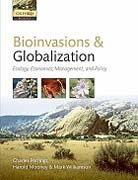
Bioinvasions and globalization: ecology, economics, management, and policy
Perrings, Charles
Mooney, Harold A.
Williamson, Mark
Bioinvasions and Globalization synthesises our current knowledge of the ecology and economics of biological invasions, providing an in-depth evaluation of the science and its implications for managing the causes and consequences of one of the most pressing environmental issues facing humanity today. Emergent zoonotic diseases such as HIV and SARS have already imposed major costs in terms of human health, whilst plant and animal pathogens have had similar effectson agriculture, forestry, fisheries. The introduction of pests, predators andcompetitors into many ecosystems has disrupted the benefits they provide to people, in many cases leading to the extirpation or even extinction of native species. This timely book analyzes the main drivers of bioinvasions - the growth of world trade, global transport and travel, habitat conversion and land useintensification, and climate change - and their consequences for ecosystem functioning. It shows how bioinvasions impose disproportionately high costs on countries where a large proportion of people depend heavily on the exploitationof natural resources. It considers the options for improving assessment and management of invasive species risks, and especially for achieving the international cooperation needed to address bioinvasions as a negative externality of international trade. INDICE: Preface 1: Charles Perrings, Harold Mooney & Mark Williamson: The problem of biological invasions Part I - The Drivers of Biological Invasions 2: Chris D Thomas & Ralf Ohlemüller: Climate change and species' distributions:an alien future? 3: Mark New & Carol McSweeney: Climate and invasive species:the limits to climate information 4: Charles Perrings, Eli Fenichel & Ann Kinzig: Globalization and invasive alien species: trade, pests and pathogens 5: Mark Williamson: Variation in the rate and pattern of spread in introduced species and its implications 6: Petr Pyšek, Milan Chytrý & Vojt?ch Jarošík: Habitats and land-use as determinants of plant invasions in the temperate zone of Europe Part II - Economics 7: R. David Simpson: If invasive species are "pollutants", should polluters pay? 8: Stephen Polasky: A model of prevention, detection, and control for invasive species 9: David Finnoff, Alexei Potapov & Mark A. Lewis: Second best policies in invasive species management: when are they "good enough"? 10: Michael Springborn, Christopher Costello & Peyton Ferrier: Optimal random exploration for trade-related non-indigenous species risk 11: Julia Touza, Martin Drechsler, Karin Johst & Katharina Dehnen-Schmutz: The role of space in invasive species management Part III - Management and Policy 12: Liba Pejchar Goldstein and Harold Mooney: The impact of invasive alien species on ecosystem services and human well-being 13: B.W. van Wilgen & D.M. Richardson: Current and future consequences of invasion by alien species: A case study from South Africa 14: R. Uma Shaanker, Gladwin Joseph, N. A. Aravind, Ramesh Kannan & K. N. Ganeshaiah: Invasive plants in tropical human dominated landscapes: need for an inclusive management strategy 15: Reuben P. Keller & David M. Lodge: Prevention: designing and implementing national policy and management programs to reduce the risks from invasive species 16: Charles Perrings, Stas Burgiel, Mark Lonsdale, Harold Mooney & Mark Williamson: Globalization and bioinvasions: the international policy problem Appendix 1: Agreement on the Application of Sanitary and Phytosanitary Measures (1995), Articles 1-11 Appendix 2 - International Health Regulations (2005) Articles 2, 5-13 Index
- ISBN: 978-0-19-956016-5
- Editorial: Oxford University
- Encuadernacion: Rústica
- Páginas: 288
- Fecha Publicación: 24/12/2009
- Nº Volúmenes: 1
- Idioma: Inglés
